
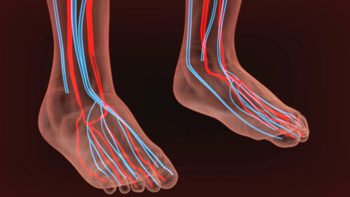
Enhancing foot circulation is critical for overall foot health and can be achieved through several practical methods. Elevating the feet above heart level helps facilitate blood flow back to the heart, reducing swelling and promoting circulation. Managing stress levels is beneficial, as stress constricts blood vessels, impacting circulation negatively. Compression stockings provide gentle pressure that aids blood return from the feet to the heart, especially useful for those who stand or sit for long periods. Regular stretching exercises, such as ankle circles and toe curls, stimulate circulation and maintain flexibility in the feet and ankles. Incorporating daily walks or light aerobic exercises improves cardiovascular health, enhancing overall circulation throughout the body, including the feet. If you have symptoms of poor foot circulation, it is suggested that you contact a podiatrist who can help you to manage this condition.
While poor circulation itself isn’t a condition; it is a symptom of another underlying health condition you may have. If you have any concerns with poor circulation in your feet contact Dr. Harris L. Klear of Burlington County Podiatry Associates. Our doctor will treat your foot and ankle needs.
Poor Circulation in the Feet
Peripheral artery disease (PAD) can potentially lead to poor circulation in the lower extremities. PAD is a condition that causes the blood vessels and arteries to narrow. In a linked condition called atherosclerosis, the arteries stiffen up due to a buildup of plaque in the arteries and blood vessels. These two conditions can cause a decrease in the amount of blood that flows to your extremities, therefore resulting in pain.
Symptoms
Some of the most common symptoms of poor circulation are:
Treatment for poor circulation often depends on the underlying condition that causes it. Methods for treatment may include insulin for diabetes, special exercise programs, surgery for varicose veins, or compression socks for swollen legs.
As always, see a podiatrist as he or she will assist in finding a regimen that suits you. A podiatrist can also prescribe you any needed medication.
If you have any questions, please feel free to contact one of our offices located in Marlton and Delran, NJ . We offer the newest diagnostic and treatment technologies for all your foot care needs.
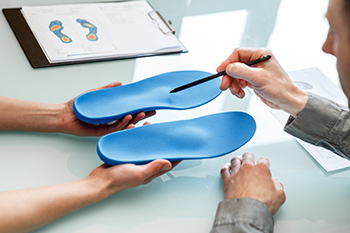 Charcot-Marie-Tooth, or CMT, disease is a hereditary condition that affects the ability of the peripheral nerves to communicate with the muscles, joints, and skin. A progressive condition, Charcot-Marie-Tooth disease affects the lower extremities first, leading to muscle weakness and atrophy, particularly in the legs and feet. Symptoms such as balance difficulties, high foot arches, twisted ankles, and foot slapping can make walking and finding appropriate footwear challenging. With no cure available, managing CMT involves stretching and exercise techniques to preserve muscle strength and flexibility, while orthotic devices and braces can provide much-needed support for improved mobility. In severe cases, surgery might be necessary to correct bone deformities. Consulting a podiatrist can be particularly beneficial in managing CMT-related foot issues, offering personalized treatments and recommendations to enhance quality of life. If you are suffering from a rare foot condition, such as CMT, it is suggested that you schedule an appointment with a podiatrist for guidance in managing its symptoms.
Charcot-Marie-Tooth, or CMT, disease is a hereditary condition that affects the ability of the peripheral nerves to communicate with the muscles, joints, and skin. A progressive condition, Charcot-Marie-Tooth disease affects the lower extremities first, leading to muscle weakness and atrophy, particularly in the legs and feet. Symptoms such as balance difficulties, high foot arches, twisted ankles, and foot slapping can make walking and finding appropriate footwear challenging. With no cure available, managing CMT involves stretching and exercise techniques to preserve muscle strength and flexibility, while orthotic devices and braces can provide much-needed support for improved mobility. In severe cases, surgery might be necessary to correct bone deformities. Consulting a podiatrist can be particularly beneficial in managing CMT-related foot issues, offering personalized treatments and recommendations to enhance quality of life. If you are suffering from a rare foot condition, such as CMT, it is suggested that you schedule an appointment with a podiatrist for guidance in managing its symptoms.
Some foot conditions may require additional professional care. If you have any concerns, contact Dr. Harris L. Klear of Burlington County Podiatry Associates. Our doctor can provide the care you need to keep you pain-free and on your feet.
Rare Foot Conditions
The majority of foot conditions are common and can be treated by a podiatrist. Standard diagnostic procedures are generally used to identify specific conditions and treatment can be rendered. A podiatrist also treats rare foot conditions which can be difficult to diagnose and may need extra attention and care.
There are many rare foot conditions that can affect children. Some of these can include:
Freiberg’s disease - This can be seen as a deterioration and flattening of a metatarsal bone that exists in the ball of the foot. It typically affects pre-teen and teenage girls, but can affect anyone at any age. Symptoms that can accompany this can be swelling, stiffness, and the patient may limp.
Kohler’s disease - This often targets the bone in the arch of the foot and affects younger boys. It can lead to an interruption of the blood supply which ultimately can lead to bone deterioration. The patient may limp or experience tenderness, swelling, and redness.
Maffucci syndrome - This affects the long bones in a child’s foot leading to the development of abnormal bone lesions. They are benign growths and typically develop in early childhood and the bones may be susceptible to breaking.
A podiatrist can properly diagnose and treat all types of rare foot conditions. If your child is affected by any of these symptoms or conditions, please don’t hesitate to call our office so the correct treatment method can begin.
If you have any questions please feel free to contact one of our offices located in Marlton and Delran, NJ . We offer the newest diagnostic tools and technology to treat your foot and ankle needs.
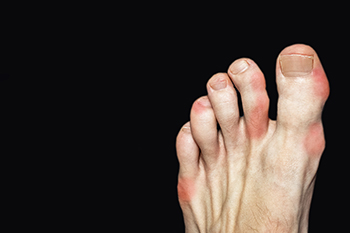 Gout is a type of arthritis that causes sudden, severe attacks of pain, redness, and tenderness in joints, often affecting the feet. It occurs when urate crystals accumulate in the joints, causing inflammation and intense pain. These crystals form when there are high levels of uric acid in the blood. The body produces uric acid when it breaks down purines, substances found naturally in the body, and certain foods. Gout can affect anyone, but it is more common in men, postmenopausal women, and individuals with kidney disease or a family history of gout. In the feet, gout typically impacts the big toe, but it can also affect other parts like the ankles and heels. The pain can be excruciating, described as a burning or stabbing sensation, often waking individuals from sleep. Swelling, redness, and warmth in the affected area are common symptoms. To manage gout, lifestyle changes such as diet modification, weight loss, and avoiding alcohol are recommended. Medications to reduce uric acid levels and inflammation may also be prescribed. If you experience severe foot pain due to gout, it is suggested that you schedule an appointment with a podiatrist for targeted treatment and management strategies.
Gout is a type of arthritis that causes sudden, severe attacks of pain, redness, and tenderness in joints, often affecting the feet. It occurs when urate crystals accumulate in the joints, causing inflammation and intense pain. These crystals form when there are high levels of uric acid in the blood. The body produces uric acid when it breaks down purines, substances found naturally in the body, and certain foods. Gout can affect anyone, but it is more common in men, postmenopausal women, and individuals with kidney disease or a family history of gout. In the feet, gout typically impacts the big toe, but it can also affect other parts like the ankles and heels. The pain can be excruciating, described as a burning or stabbing sensation, often waking individuals from sleep. Swelling, redness, and warmth in the affected area are common symptoms. To manage gout, lifestyle changes such as diet modification, weight loss, and avoiding alcohol are recommended. Medications to reduce uric acid levels and inflammation may also be prescribed. If you experience severe foot pain due to gout, it is suggested that you schedule an appointment with a podiatrist for targeted treatment and management strategies.
Gout is a painful condition that can be treated. If you are seeking treatment, contact Dr. Harris L. Klear from Burlington County Podiatry Associates. Our doctor will treat your foot and ankle needs.
What Is Gout?
Gout is a form of arthritis that is characterized by sudden, severe attacks of pain, redness, and tenderness in the joints. The condition usually affects the joint at the base of the big toe. A gout attack can occur at any random time, such as the middle of the night while you are asleep.
Symptoms
Risk Factors
Prior to visiting your podiatrist to receive treatment for gout, there are a few things you should do beforehand. If you have gout you should write down your symptoms--including when they started and how often you experience them, important medical information you may have, and any questions you may have. Writing down these three things will help your podiatrist in assessing your specific situation so that he or she may provide the best route of treatment for you.
If you have any questions, please feel free to contact one of our offices located in Marlton and Delran, NJ . We offer the newest diagnostic and treatment technologies for all your foot care needs.
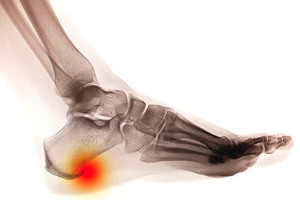
Heel spurs are calcium deposits that develop on the underside of the heel bone, often without causing any discomfort. However, when the plantar fascia ligament, which connects the heel to the toes, undergoes excessive tension or strain, it can become inflamed. This may lead to a condition known as plantar fasciitis, which can cause the heel spur to press into the swollen ligament and cause significant pain. While heel spurs themselves are generally painless, they frequently accompany plantar fasciitis, with about 70 percent of cases showing the presence of a heel spur. Preventative measures include wearing shoes with proper arch support, using heel pads, maintaining a healthy weight, and performing calf stretches before engaging in strenuous activities. A podiatrist can provide a comprehensive treatment plan tailored to your specific needs, which may include custom orthotics, physical therapy, and recommendations for supportive footwear. Surgery may be needed to address severe cases, though it carries risks such as increased pain, nerve damage, and fallen arches. If you are experiencing heel pain, it is suggested that you make an appointment with a podiatrist for an exam and treatment.
Heel spurs can be incredibly painful and sometimes may make you unable to participate in physical activities. To get medical care for your heel spurs, contact Dr. Harris L. Klear from Burlington County Podiatry Associates. Our doctor will do everything possible to treat your condition.
Heels Spurs
Heel spurs are formed by calcium deposits on the back of the foot where the heel is. This can also be caused by small fragments of bone breaking off one section of the foot, attaching onto the back of the foot. Heel spurs can also be bone growth on the back of the foot and may grow in the direction of the arch of the foot.
Older individuals usually suffer from heel spurs and pain sometimes intensifies with age. One of the main condition's spurs are related to is plantar fasciitis.
Pain
The pain associated with spurs is often because of weight placed on the feet. When someone is walking, their entire weight is concentrated on the feet. Bone spurs then have the tendency to affect other bones and tissues around the foot. As the pain continues, the feet will become tender and sensitive over time.
Treatments
There are many ways to treat heel spurs. If one is suffering from heel spurs in conjunction with pain, there are several methods for healing. Medication, surgery, and herbal care are some options.
If you have any questions feel free to contact one of our offices located in Marlton and Delran, NJ . We offer the latest in diagnostic and treatment technology to meet your needs.
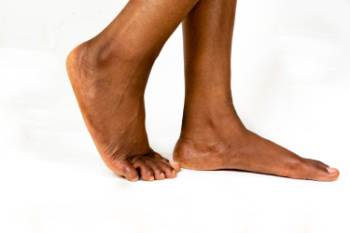
Flatfoot, also known as pes planus, is a condition where the arch of the foot collapses, causing the entire sole to touch the ground. This can affect one or both feet and is common in children and adults. Many people with flat feet may develop pain due to changes in activity, minor injuries, weight gain, or wearing poorly fitted footwear. Symptoms can include foot discomfort and leg aches, particularly after prolonged standing, walking, or running. Relief may come from wearing comfortable shoes with proper arch support. Orthotic devices, such as heel cups or custom-made inserts, can help balance the foot and reduce impact. Stretching exercises, such as calf stretches and towel curls, can strengthen the muscles and help alleviate pain. For children, special corrective measures are rarely needed as their arches typically develop by age five. In most cases, surgery is unnecessary. Additional relief can be found through the use of non-steroidal anti-inflammatory drugs, heat, or massage therapy. If flatfoot is related to another medical condition, more specific treatments might be required. To effectively manage and treat flatfoot, it is suggested that you schedule an appointment with a podiatrist for an exam and to see if custom orthotics are right for you.
Flatfoot is a condition many people suffer from. If you have flat feet, contact Dr. Harris L. Klear from Burlington County Podiatry Associates. Our doctor will treat your foot and ankle needs.
What Are Flat Feet?
Flatfoot is a condition in which the arch of the foot is depressed and the sole of the foot is almost completely in contact with the ground. About 20-30% of the population generally has flat feet because their arches never formed during growth.
Conditions & Problems:
Having flat feet makes it difficult to run or walk because of the stress placed on the ankles.
Alignment – The general alignment of your legs can be disrupted, because the ankles move inward which can cause major discomfort.
Knees – If you have complications with your knees, flat feet can be a contributor to arthritis in that area.
Symptoms
Treatment
If you are experiencing pain and stress on the foot you may weaken the posterior tibial tendon, which runs around the inside of the ankle.
If you have any questions please feel free to contact one of our offices located in Marlton and Delran, NJ . We offer the newest diagnostic and treatment technologies for all your foot and ankle needs.